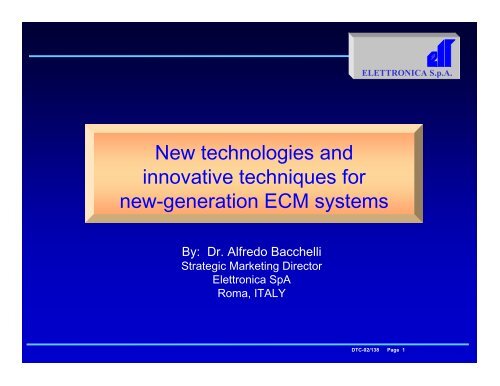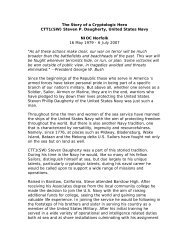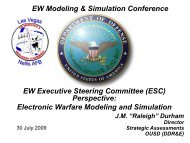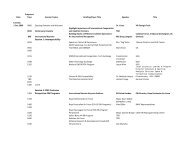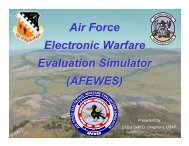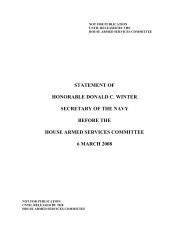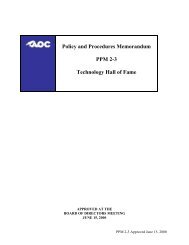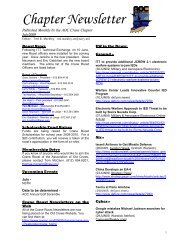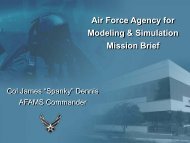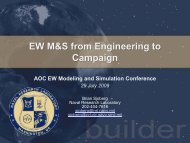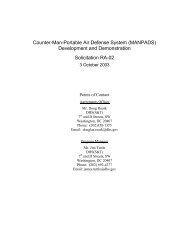New technologies and innovative techniques for new-generation ...
New technologies and innovative techniques for new-generation ...
New technologies and innovative techniques for new-generation ...
You also want an ePaper? Increase the reach of your titles
YUMPU automatically turns print PDFs into web optimized ePapers that Google loves.
ELETTRONICA S.p.A.<strong>New</strong> <strong>technologies</strong> <strong>and</strong><strong>innovative</strong> <strong>techniques</strong> <strong>for</strong><strong>new</strong>-<strong>generation</strong> ECM systemsBy: Dr. Alfredo BacchelliStrategic Marketing DirectorElettronica SpARoma, ITALYDTC-02/138 Page 1
Summary• Self-Protection ECM systems presently installed onboard NATO<strong>for</strong>ces’ aircraft <strong>and</strong> ships have demonstrated in several occasionsa good level of effectiveness, but the continual evolution of radarguidedthreats dem<strong>and</strong>s <strong>for</strong> a parallel evolution of the ECM assets• This paper describes two recent examples of this evolution: A <strong>new</strong> ECM-system architecture, developed by Elettronica SpAof Roma (ITALY), taking advantage of its latest achievementsin various fields: antenna design, solid-state high-power microwaveamplifiers <strong>and</strong> high-density circuit packaging Use of this architecture to implement, in a real system, <strong>innovative</strong>ECM <strong>techniques</strong> such as Cross-Eye & Cross-Pol, the firsthaving been successfully demonstrated in the frame of a longtermcooperation between Elettronica <strong>and</strong> the Italian MODDTC-02/138 Page 2
The BackgroundFrom the beginning of its activity in the EW field, about 50 years ago,Elettronica designed <strong>and</strong> produced ECM systems to be installedonboard various types of military plat<strong>for</strong>ms:– aircraft & helicopters (self & mutual protection ECM)– military ships (self defence ECM)– ground mobile stations (point/area defence ECM)DTC-02/138 Page 3
ECM Transmitter technology• In most Radar Jammers of traditional design, RF power amplificationwas provided by vacuum tubes (typically TWTs) <strong>and</strong> ECMsignals were in general radiated through single-beam antennas• Drawbacks <strong>and</strong> limitations of this HW approach are well known:– Long “warm-up” time (from switch-on to transmission)– Tx reliability often unsatisfactory, mainly due to TWT’s highvoltagerequirement of <strong>and</strong> to their limited life– Reliable operation at high altitude (or in high-humidity environment),can be obtained only through a very smart Tx design– Multi-threat ECM capability is often limited to a maximum oftwo simultaneous threats, especially when the ECM signal isradiated through high-gain single-beam antennas– Dem<strong>and</strong>ing logistic support (mainly due to use of limited-lifecomponents: primarily the TWT transmitting tubes)– High through-life costDTC-02/138 Page 4
PHASED-ARRAY ANTENNAS• Phased-array technique, withthe possibility of electronicbeam aiming, permits to designECM systems capable ofsimultaneous ECM reactionsagainst multiple threats, invarious directions• NETTUNO system has been thefirst Elettronica’s naval ECMproduct using this solution• However, the other problemsrecalled above <strong>and</strong> all related tothe use of TWTs, remained unsolvedNettuno System’s ECM antennas, onboardthe Italian-Navy carrier “Garibaldi”DTC-02/138 Page 5
Modern Anti-Ship Missile ThreatsDTC-02/138 Page 6
<strong>New</strong> threats <strong>and</strong> <strong>new</strong> ECM needs• To effectively counter the <strong>new</strong> radar <strong>and</strong> missile threats, ECM systemsmust have features that were in general not implemented (or not availableall together), in the previous <strong>generation</strong> systems:1 – Effectiveness against all modern radar types (<strong>for</strong> both search <strong>and</strong>tracking, including coded, coherent <strong>and</strong> monopulse types)2 – Capability of multiple reactions against multiple simultaneousthreats, in different RF b<strong>and</strong>s <strong>and</strong> coming from different directions3 – Capability of electronic ECM-beam aiming not only to any azimuth,but also to any elevation angle, within a wide overall field4 – Very high “mission success probability” , which implies:• high reliability <strong>and</strong> availability,• good failure resistance,• minimisation (or total absence) of limited life components <strong>and</strong>of mechanical moving parts,• simple <strong>and</strong> fast maintenanceDTC-02/138 Page 7
DRFM “Exciters”: the key ECM resourceagainst coded/coherent threat radarsDESIGNATIONFROM ESMT/R SWITCH TO/FROMANTENNADIGITALMEMORYI/OCPUPRITRACKERSDIGITALMEMORYI/OLODRFMLOCAL BUSDTC-02/138 Page 8
“ECM Exciters” using DRFM• As phased-array techniquehas been the key elementto implement multi-threatjammers, the use of DRFMimproved in a significantmanner the ECM systemcapability to jam (or todeceive) coded or coherentradars <strong>and</strong> missile-seekers• The first DRFM produced byElettronica (1993-95) was a2-bit model, originally used<strong>for</strong> an airborne self-protectionjammer (ELT/553) →ELT/553(V)3 SPJTechniques GeneratorDRFM boardWideb<strong>and</strong> RF tuning moduleDTC-02/138 Page 9
The <strong>new</strong>-<strong>generation</strong> multi-bit DRFM• Implementation Technology– FPGA (Field Programmable Gate Array)– ASIC (Application-Specific Integrated Circuit)• Interconnection Technology:– SMT (Surface Mounted Technology)– MCM (Multi-Chip Module)– etcDTC-02/138 Page 10
The EFA project: a great opportunity <strong>for</strong>a step ahead in ECM technology• When EFA project was launched, at the end of the ‘80s, Solid-State ECM was the “dream in the drawer” of many EW designers• Potential benefits of Solid-State technology, if used to design anactive-array ECM antenna, were (<strong>and</strong> are) extremely attractive:– feasibility of arrays with very wide space coverage– true modularity in terms of ERP– high overall efficiency (power consumption versus ERP)– better EMC behaviour <strong>for</strong> a given ERP (interoperability)– elimination of high voltage power supply– extremely high reliability <strong>and</strong> fault tolerance– simplified logistics <strong>and</strong> lower through-life cost• Semiconductor technology <strong>for</strong> power amplification in microwaveb<strong>and</strong> was progressing, although in a rather slow mannerDTC-02/138 Page 11
The road to the “Solid-State ECM”• In the EFA project requirements, the ERP level <strong>and</strong> the other per<strong>for</strong>mancespecifications, though dem<strong>and</strong>ing, were matching withthe possible features of an active phased array solution• At that time the Output Power available from solid-state amplifierswas just sufficient to reach the specified ERP with a “realistic”active phased-array solution, but it was promising to grow by afew more dB in the years to come, during system development• Time <strong>and</strong> money <strong>for</strong> an <strong>innovative</strong> development were available• On these assumptions, Elettronica defined a fully solid-state SPJ(Self-Protection Jammer), compliant with the EFA requirement• Then ELT established an alliance with GEC Marconi (now BAE-Systems) in a consortium named Eurodass; they jointly prepareda fully solid-state DASS proposal <strong>for</strong> EFA <strong>and</strong> won the tender:The first all-solid-state ECM project was launchedDTC-02/138 Page 12
From conventional Tx to Phased ArrayToday, Today, SSA SSA architecture permits permits to to obtain: obtain:•• The The same same ERP ERP “class” “class” of of TWT TWT systems systems•• Lower Lower Weight Weight & Power Power Consumption•• Better Better A/ϕ A/ϕ stability stability & control control•• Better Better reliability <strong>and</strong> <strong>and</strong> availabilityAs As known, known, accurate accurate & stable stable A/ϕ A/ϕ control control is isa key key feature feature to to implement Cross-Eye ECM ECMDTC-02/138 Page 13
The Eurofighter EF-2000 “Typhoon”DTC-02/138 Page 14
The EFA-DASS Antenna/Transceiver Unit(main item of Elettronica’s work-share)Power Supply Transceivers’ packet Transmitting/receivingantenna arrayDTC-02/138 Page 15
THE ANTENNA ARRAY(linear array of multi-notch Vivaldi elements)One of the various experimental antenna arrays made<strong>and</strong> extensively tested during system developmentDTC-02/138 Page 16
TRANSCEIVER MODULE(The Pre-Production model)The transceiver module already produced in small series <strong>for</strong> theSS-ECM systems delivered during the pre-production phaseDTC-02/138 Page 18
A <strong>new</strong>-<strong>generation</strong> airborne ECM system• The <strong>new</strong> Elettronica Modular Airborne ECM System consists of:– A DRFM-based Techniques Generator, incorporating also thecircuits <strong>for</strong> passive emitter tracking <strong>and</strong> the reaction-managementcomputer– Active Phased-Array (APA) antennas, in number sufficient tocover all the sectors of interest, each composed of the appropriatenumber of elements to produce the required ERP(Effective Radiated Power)• The Techniques Generator may optionally include the circuits required<strong>for</strong> implementation of Cross-Eye <strong>and</strong> of other ECM <strong>techniques</strong>requiring accurate amplitude, phase <strong>and</strong> polarisation control• For each APA unit, two physical configurations are proposed:– the “Integral” one (as already seen <strong>for</strong> the EFA-DASS)– the “split” one, in which the packet of transceivers <strong>and</strong> thearray of radiating elements are two separate unitsDTC-02/138 Page 19
An example of “split” SS-ECM structure:the HDJ-X ECM <strong>for</strong> Combat-Helicopters• Helo RF/SPJ needs:– All-around protection– Instantaneous response– High ERP– Lightweight & low powerconsumption units– High availability (faulttolerant architecture)A B• Solution: a Solid State ECM, composed of three “parts”:– a compact DRFM-based Exciter (not shown),– a single-unit transceiver assembly (A),– a multiple-array antenna assembly (B)DTC-02/138 Page 20
Operational Flexibility• Implementation of Cross-Eye (X/E) requires two ECM antennas <strong>for</strong>each angular sector to be covered• This need, which in a first instance could be seen as a negativecost-increase factor, gives the system (in addition to outst<strong>and</strong>ingX/E capabilities against monopulse radars) also an excellentoperational flexibility• The two ECM antennas, in fact, may be used in various modes,either by co-operating in countering the same threats, or workingindependently one from the other, against different threats• Due to system capabilities in terms of amplitude & phase control,“cooperative” modes are not limited to Cross-Eye, but include:– In-phase multi-threat jamming, with on-target ERP being 6 dBhigher than the value provided by a single APA antenna– Other non-conventional ECM <strong>techniques</strong>, made possible inthis system by its excellent signal control featuresDTC-02/138 Page 21
Operational Flexibility: an exampleFOV-RFOV-F In this aircraft, each pair of ECM antennascovering the same FOV (i.e.the Front or Rear sector) can be usedin either independent or co-operativereaction mode, according to real-timemission needs♦FOV-RFOV-FIn “independent” mode, the two antennasmay provide fully independentreaction against different threats.As an example, one antenna may jamone threat with continuous noise, whilethe other reacts to other threats♦In co-operative mode, the system permitsthree alternative multi-threat capabilities: In-phase combined-power ECM (withon-target power increase of 6 dB) On-Target Phase-opposition ECM(<strong>for</strong> Cross-Eye angular deception) Other “non-conventional” ECM<strong>techniques</strong>, (which however mayrequire modified antenna elements)DTC-02/138 Page 22
Solid-State Technology<strong>for</strong> Naval ECM tooDTC-02/138 Page 23
Effective Radiated Power (ERP)Requirement in today’s naval scenario• When the first hypothesis of a solid-state naval jammer was made,the first quite unanimous comment was: “No! You cannot get fromthese stupid transistors enough power <strong>for</strong> a “serious” naval ECM”• As we will see, this statement is wrong: today’s solid-state technologypermits to get from a fully solid-state naval jammer the sameERP of the TWT-based ECM systems now present on the market• For the same ERP class, however, the <strong>new</strong> solid-state jammersfrom ELT are lighter in weight, definitely smaller in size <strong>and</strong> muchmore efficient in power consumption (ERP versus power drain)• Last, but not least, solid-state jammers are far superior to TWTbasedsystems in terms of mission success probability, due to thegood MTBF of the active modules, the failure-tolerant nature of theActive Phased Array <strong>and</strong> the absence of limited-life componentsDTC-02/138 Page 24
ERP of an “active-array” antenna• Assuming that in our APA-ECM system:– each single element of the array antenna will be fed by adedicated mini-transmitter,– the antenna elements will have a uni<strong>for</strong>m <strong>and</strong> optimisedspacing within the array area,then the ERP of the active array antenna can be approximated as:ERP = P elem • N 2 • Gwhere:– P elemis the output power of each mini-transmitter element– N is the number of active antenna elements in the array (equalto the number of mini-transmitters)– G is the gain of a single element of the array (when mounted inthe actual array)DTC-02/138 Page 25
Typical ERP provided by Planar ArraysERP (dBm) v/s element power <strong>and</strong> array population:100908070601W2W4W8WElementPower5032 64 128 256Array population (qty of active elements)DTC-02/138 Page 26
NETTUNO-4100 “Fully-Solid-State”Naval-ECM System• A market analysis indicated that ERP requirements of naval ECMtend to concentrate in three “power classes”, aimed to differentship types <strong>and</strong> separated by about 5 or 6 dB one from the other:– Level A (moderate ERP) <strong>for</strong> OPV <strong>and</strong> Corvettes– Level B (high ERP) <strong>for</strong> Frigates– Level C (very high ERP), <strong>for</strong> larger ships or <strong>for</strong> area-protection• For this <strong>new</strong> Solid-State ECM, ELT selected a modular design,aimed to fulfil the needs of all the above ERP requirements; threemodels of Antenna Unit (A, B <strong>and</strong> C) have there<strong>for</strong>e been defined• The main features of the <strong>new</strong> Antenna Unit are:– Modular design (in number of elements <strong>and</strong> there<strong>for</strong>e in ERP)– Receiving <strong>and</strong> Transmitting, Planar Active Phased Array type,with automatic passive tracking of multiple threats– Azimuth coverage: 180° with two planar arrays <strong>for</strong> each unitDTC-02/138 Page 27
NETTUNO 4100 PICTORIAL VIEW/PORT/STARBOARDDTC-02/138 Page 28
NETTUNO 4100 ANTENNABLOCK DIAGRAMDTC-02/138 Page 29
Nettuno-4100 Antenna Unit (mod. AØ)• Two units of this experimentalmodel (with a single antennaarray) have been constructed,installed on an Italian Navyfrigate <strong>and</strong> extensively tested,to demonstrate:– Overall System functionality– Ability to track radar threatswith the specified accuracy(two axis tracking: azimuth<strong>and</strong> elevation), while compensating<strong>for</strong> ship motions– Compliance with the predicted“on target” ECM level– Real per<strong>for</strong>mances of a <strong>new</strong>ECM technique: Cross-EyeDTC-02/138 Page 30
ANTENNA SUB-ARRAY & MODULESDTC-02/138 Page 31
The “dual output” Transceiver Moduledesigned <strong>for</strong> Nettuno-4100DTC-02/138 Page 32
NETTUNO-4100 Antenna Unit (mod. B)• Nettuno 4100 Antenna Unit<strong>for</strong> medium-size ships• Intermediate ERP class• Fully solid-state• Narrow-beam radiation<strong>and</strong> programmable-beamreception• 180° FOV in azimuth <strong>for</strong>both signal reception <strong>and</strong>ECM transmission• Wide FOV in elevation• Automatic <strong>and</strong> very accuratetarget tracking• Electronic beam stabilisation(no mobile parts)DTC-02/138 Page 33
TARGET ACQUISITION (Phase I: signalacquisition & position assessment)DTC-02/138 Page 34
TARGET ACQUISITION (Phase II: positionrefinement <strong>and</strong> tracking stabilisation)DTC-02/138 Page 35
NETTUNO-4100 “BONUS”:The “High Sensitivity Special Search Mode”A: ESM Interception rangeB: Nettuno-ECM Search RadiusC: Nettuno-ECM HS-Search IFOVABCDTC-02/138 Page 36
A reminder ofCross-Eye Technique<strong>and</strong> related Field TrialsDTC-02/138 Page 37
Cross-Eye Technique - The theory (1)• Cross-Eye ECM technique, asdescribed in the EW literature,consists of the emission, from theX/E plat<strong>for</strong>m, of a modified radarecho, characterised by a specifictype of “wavefront distortion” inthe direction of the radar emitter• This may be obtained by radiatingfrom two physically separate ECMantennas, located at a mutual distance“L”, two amplified radar-echoreplicas, with a specific (<strong>and</strong> accuratelycontrolled) amplitude <strong>and</strong>phase relation between themCross-EyePlat<strong>for</strong>mLCross-EyeAntennasWeapon RadarAntennaDTC-02/138 Page 38
Cross-Eye Technique - The theory (2)• When receiving an echowith “distorted wavefront”,the radar (whichever its DFtechnique) will always seethe target in a directionorthogonal to the “best-fitequiphase plane” at theradar-antenna position• This directional in<strong>for</strong>mationwill there<strong>for</strong>e be wrong <strong>and</strong>the error δ will be directlyproportional to the actualwavefront-distortion factor“Apparent”target positionUndistortedWavefrontEquiphasePlaneDδ90°True target positionδRadar positionLinear Error “D”DistortedWavefrontDTC-02/138 Page 39
X/E ECM attractiveness• The possibility to deceive in angle all types of radar trackers <strong>and</strong>seekers (including the “monopulse” ones) using an on-board ECMequipment is extremely attractive• Other important <strong>and</strong> unique features of X/E ECM, are that:– the displacement error (D) induced in the victim radar is stable<strong>and</strong> fully predictable– the false target generated by X/E is not “additional” to the realone <strong>and</strong> does not represent <strong>for</strong> the radar (as it happens withthe off-board ECM types) an “alternative” to the real target• With X/E, the radar sees <strong>and</strong> tracks at all time one <strong>and</strong> only onetarget, but the measured target direction is wrong <strong>and</strong> the radar(or its operator) has no elements to suspect to be subject to ECMIf this is true, why X/E ECM has not been implemented ?DTC-02/138 Page 40
Hardware implementation criticality• The main reason that until now has not permitted implementationof X/E systems is that Cross-Eye, to induce into the radar (or intothe missile seeker) “useful” DF errors, requires a very accurateamplitude <strong>and</strong> phase control of the radiated ECM signals• The well known “X/E Gain” graphic function, shown in last year’spaper, indicates that, in order to have a good X/E error (e.g. D=10times the baselength L), we need an overall control (<strong>and</strong> stability)of the radiated signals better than a couple of degrees in phase<strong>and</strong> less than one dB in amplitude; both these features are far betterthan those usually provided by the traditional ECM hardwareCross-Eye implementation requires hardwarewith definitely better A/ϕ per<strong>for</strong>mancesDTC-02/138 Page 41
The Elettronica solution• The architectural approach followed by Elettronica <strong>for</strong> X/E implementationoffers a satisfactory answer to all above problems• The key points that made this solution working <strong>and</strong> effective are:1 – adoption of a retro-reflective architecture2 – use of the same antennas to receive <strong>and</strong> to transmit, whichguarantees to have perfectly coincident centers of phase3 – adoption of active phased-array antennas, with fully solid-statetransmitters, to get excellent phase matching <strong>and</strong> control4 – last, adoption of a multi-bit DRFM <strong>for</strong>:• <strong>generation</strong> of high fidelity replicas of all signal types(including complex/coded/coherent wave<strong>for</strong>ms)• accurate phase/time control of the replicas• <strong>generation</strong> of all the traditional ECM <strong>techniques</strong>, <strong>for</strong> whichX/E represents a “main add-on”DTC-02/138 Page 42
Solid-State APA Advantages <strong>for</strong> X/E• The use of a fully-Solid-State Active Phased Array (APA) antennaguarantees superior A/ϕ per<strong>for</strong>mances with respect to any otherconventional (TWT-based) solution, due to three main factors:– the better phase matching of solid-state transmitters withrespect to TWTs (SSA, with their wavelength-comparablephysical size, are much smaller of TWTs <strong>and</strong> also of MPMs)– the easier, faster <strong>and</strong> more accurate amplitude control thatmay be obtained with Solid-State Transmitters– the fact that any instantaneous mismatching (in phase <strong>and</strong>/orin amplitude) among the elements of the active array is automaticallyaveraged by the array effect, which grants a muchbetter phase <strong>and</strong> amplitude behaviour of the whole array withrespect to the single transceiver elementsDTC-02/138 Page 43
X/E Field Trials (1988-2000)• X/E has been extensively tested, with the essential cooperation ofthe Italian Air-Forece <strong>and</strong> Navy, during five field test exercises:– Session 1: Small Helo (1988)– Session 2: Shipborne X/E (1993)– Session 3: Small Helo (1999)– Session 4: Jet A/C (1999)– Session 5: Ship (2000)• The 1999-2000 trials have been conducted in realistic combat-likeradar engagements, using “full-features” X/E systems; test resultshave been positive in all sessions <strong>and</strong> have demonstrated that:– avionic X/E is now “mature” <strong>for</strong> use onboard combat aircraft– naval X/E, although fully satisfactory in almost all of the testruns, can still improve through further hardware refinement<strong>and</strong> optimisation of target engagement softwareDTC-02/138 Page 44
Conclusions• Solid-State ECM systems developed by Elettronica in the last few yearshave reached production <strong>and</strong> will be soon operational• They provide enough ERP not only <strong>for</strong> fighters <strong>and</strong> helos, but also <strong>for</strong> shipsof various classes, from FPB to Frigates/Destroyers• Cross-Eye technique, as implemented by Elettronica, demonstrated to beeffective, robust <strong>and</strong> reliable <strong>and</strong> also to grant the “extra per<strong>for</strong>mance” <strong>for</strong>which it was developed: angular deception of monopulse radars• These two elements, Solid-State ECM <strong>and</strong> Cross-Eye are strictly correlated:phased-array architecture <strong>and</strong> solid-state power amplification are bothessential to Cross-Eye, which may now exp<strong>and</strong> the range of ECM systems’<strong>techniques</strong> <strong>and</strong> capabilities to angle-deception of monopulse• Solid-state jammers, in both airborne <strong>and</strong> shipborne scenarios, may havetoday (apart <strong>for</strong> X/E capability) a competitive price versus the conventionalECM products (using TWTs), but will outclass them in terms of Reliability,Failure-Resistance <strong>and</strong> Life-Cycle CostDTC-02/138 Page 45
<strong>New</strong> <strong>technologies</strong> <strong>and</strong><strong>innovative</strong> <strong>techniques</strong> <strong>for</strong><strong>new</strong>-<strong>generation</strong> ECM systemsThe EndDTC-02/138 Page 46


